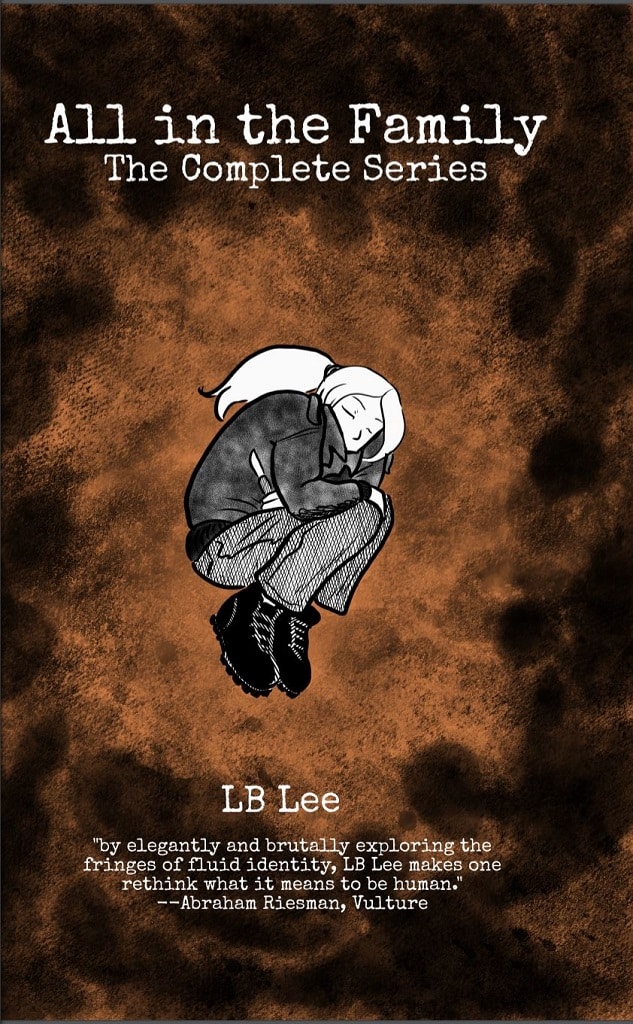Comics are unfettered by the respectable rules of the realist narrative. Dreams can bleed into waking life, metaphors can become literal, and contradictory sensory impressions can be juxtaposed without connective exposition. This is also how traumatic memories often present themselves. Graphic storytelling are an especially effective medium for depicting how abuse feels—how it alters your brain and drops you into a bizarro-world. The credibility police have no authority here.
Psychoanalyst and philosopher Alice Miller, a world-renowned expert on child abuse and its political repercussions, notably uncovered her own repressed memories by making visual art, a story she detailed in Pictures of a Childhood: Sixty-Six Watercolours and an Essay. Some of the creators listed below similarly found that they drew their way into truths that the logical, verbal part of their mind had hedged around with self-protective narratives.
Peter, the protagonist of my novel Origin Story, is mentoring a genderfluid teen at a group home when they begin collaborating on “The Poison Cure,” a noir superhero comic about a mutant who seduces child abusers to kill them with his toxic touch. At first they merely seem to be working in the queer tradition of reclaiming monstrosity: Peter is a gay man looking for love during the 1990s AIDS crisis, and Tai’s femme Black identity is pathologized by their white foster care social workers. But as he goes deeper into his psyche to access his creativity, Peter starts to have flashbacks of a violation he never suspected. Identifying the villain of “The Poison Cure” will be a clue to his real-life trauma history—if he can bear to find out.
The books in this list demonstrate the potential of graphic storytelling as a container for experiences that shatter our conventional meaning-making structures.
MAW by Jude Ellison S. Doyle
In this horror comic by the author of Dead Blondes and Bad Mothers: Monstrosity, Patriarchy, and the Fear of Female Power, a rape survivor turns into a man-eating sea monster at a women’s spiritual healing retreat. Doyle complicates binary gender politics while remaining unflinching in his exposure of toxic masculinity. The island locale off the coast of Virginia resembles a sinister version of Wonder Woman’s Themiscyra, as suggested by the name of its charismatic and chilling matriarch, Diana Spiro. Women’s space, even when it includes trans women, isn’t immune to cult dynamics or violations of bodily consent. Yet when human society denies justice to survivors, becoming inhuman can seem like the only remaining good option.
The Tale of One Bad Rat by Bryan Talbot
Quaint animal illustrations notwithstanding, Beatrix Potter actually wrote disturbing cautionary tales where the threat of predation hung over foolish females and runaway youngsters. Thus the allusion to her work makes a good framing device for this lushly illustrated full-color graphic novel about a homeless teen girl and her pet rat in contemporary Britain. When Helen runs away to escape her father’s sexual abuse, she heads for Potter’s historic home in the Lake District, which represents the childhood innocence she is determined to fight for. Potter’s example inspires her to become an artist and depict the truth about her family.
Our Little Secret: A Graphic Memoir by Emily Carrington
A story decades in the making, this memoir by a Canadian artist re-creates how she was groomed and sexually abused by her father’s friend when she was a teenager, and then her lengthy and fruitless efforts to hold him accountable through the courts. Uncluttered black-and-white line drawings broken up into small panels give this graphic narrative a low-key, almost detached aesthetic. This presentation style captures how a young person—at first naïve, then dissociated—would recount terrible facts whose significance would escape her at the time.
The amount of empty space in the drawings conveys her isolation in her father’s squalid cabin in the woods, but also the peace she found in solitude with her horse and sheep. It feels like a healing breakthrough when the final pages depart from strict realism, taking her on an inner psychic journey to rescue the abandoned part of herself.
Blackwax Boulevard Is Listening by Dmitri Jackson
A compelling narrative arc inspired by the #MeToo movement drives this second volume of Jackson’s self-published webcomic about the staff of an urban record store contending with unrequited love, addiction, fallen idols, and customers who have cringey taste in music. Chester Vick, a hard-partying music critic, is finally being held somewhat accountable for decades of preying on women, prompting some characters to defend him, and others to be angry and hurt that the “progressive” men in their life still don’t get it.
Most affected is Blackwax employee Veronika, a white woman who relapses into alcoholism because this news story triggers her memories of being sexually abused by her stepfather. The intersection of racial and sexual marginalizations causes a crisis when she calls the cops on a bombastic Black male activist who’s manhandling his girlfriend in the record store. However, Blackwax really is a place where people listen to each other, even when it’s painful. The resolution of their conflict is hopeful but not hokey.
Jackson’s work has standout composition, clarity, and dynamism. The black-and-white panels feel like a complete three-dimensional world because of effective variations in lighting, distance, and poses.

All in the Family by LB Lee
LB Lee is a transgender multiple-personality system. Their cartooning style is anime-inspired and has the simple candor of a young person’s diary combined with an adult’s tenderness toward their inner child. Subtitled “A psychological murder mystery,” All in the Family introduces us to their various headmates as they investigate why some system members have gone missing and what traumatic secrets they were created to hold.
Julio’s Day by Gilbert Hernandez
This stark but beautiful graphic novel spans 100 years in the life of a working-class Mexican-American man. Though he lives through the major events of the 20th century, life seems to pass him by, while his family members down to the great-grandchildren experience love, madness, war, and adventure. Because of his closeted homosexuality, he passes through their lives like a ghost, so alone with his emotions that they become opaque even to himself.
It takes a generation, but his family ultimately faces the fact that Julio’s uncle is a serial predator on young boys, and metes out justice without involving the legal system. However, Julio remains in denial, perhaps associating his molestation with the sexual identity he’s been taught to abhor. The book’s stream-of-consciousness structure mimics how the significant memories of a lifetime flow into one another like fleeting impressions from a dream, rather than always being connected by complete narratives.
Chartwell Manor by Glenn Head
Drawn in the explosive and grotesque style popularized by R. Crumb and Zap Comix, whose influence Head cites, this shattering black-and-white graphic memoir takes its name from the New Jersey private school for “troubled youth” where the author was sent in seventh grade. Chartwell was run by a pedophile who groomed the boys with a bewildering combination of love-bombing, corporal punishment, and sexual abuse. It’s satisfying to learn that he was eventually convicted; Head reproduces newspaper articles and photographs of the man and his victims, definitively breaking the silence. Yet the cartoonist’s own life story is a decades-long struggle with alcoholism and pornography addiction because of his trauma. The underground comix movement was a kind of savior for him, a place where taboo thoughts and extreme emotions could be brought into the open without shame.
Speak: The Graphic Novel by Laurie Halse Anderson
Eisner Award–winning graphic artist Emily Carroll adapts Anderson’s bestselling young adult novel from the 1990s about the aftermath of a date rape. Ninth-grader Melinda has gone virtually mute after a senior boy secretly assaulted her at a party the previous summer. Her parents are too preoccupied with their failing marriage to do more than punish her for her suddenly falling grades. Her classmates ostracize her for calling the police on the party, refusing to believe that their teen idol is a predator. However, an iconoclastic and devoted art teacher helps her find her voice through visual art.
This plot lends itself well to graphic storytelling, with Carroll’s pensive grayscale drawings expressing Melinda’s outer numbness and inner turmoil. An ongoing side plot about the school’s ham-fisted censorship efforts is satirically funny and timely, making it clear why Melinda feels her experience is unspeakable in her community.
Read the original article here


